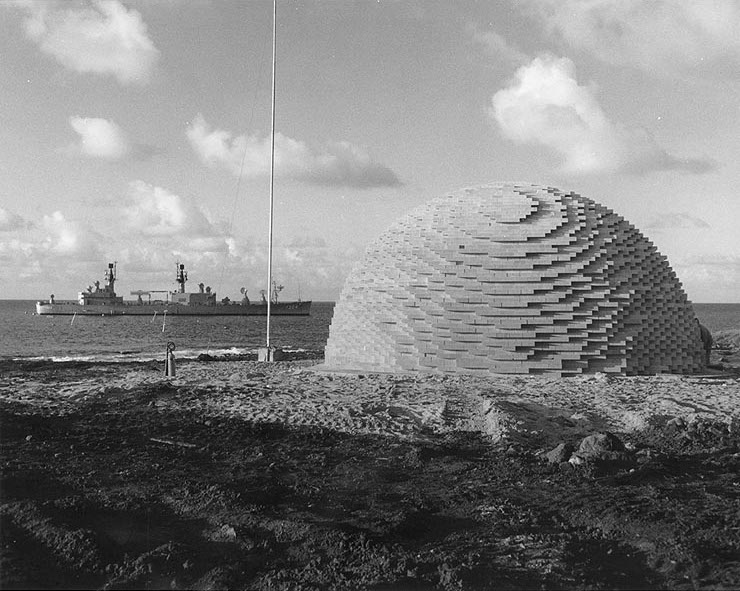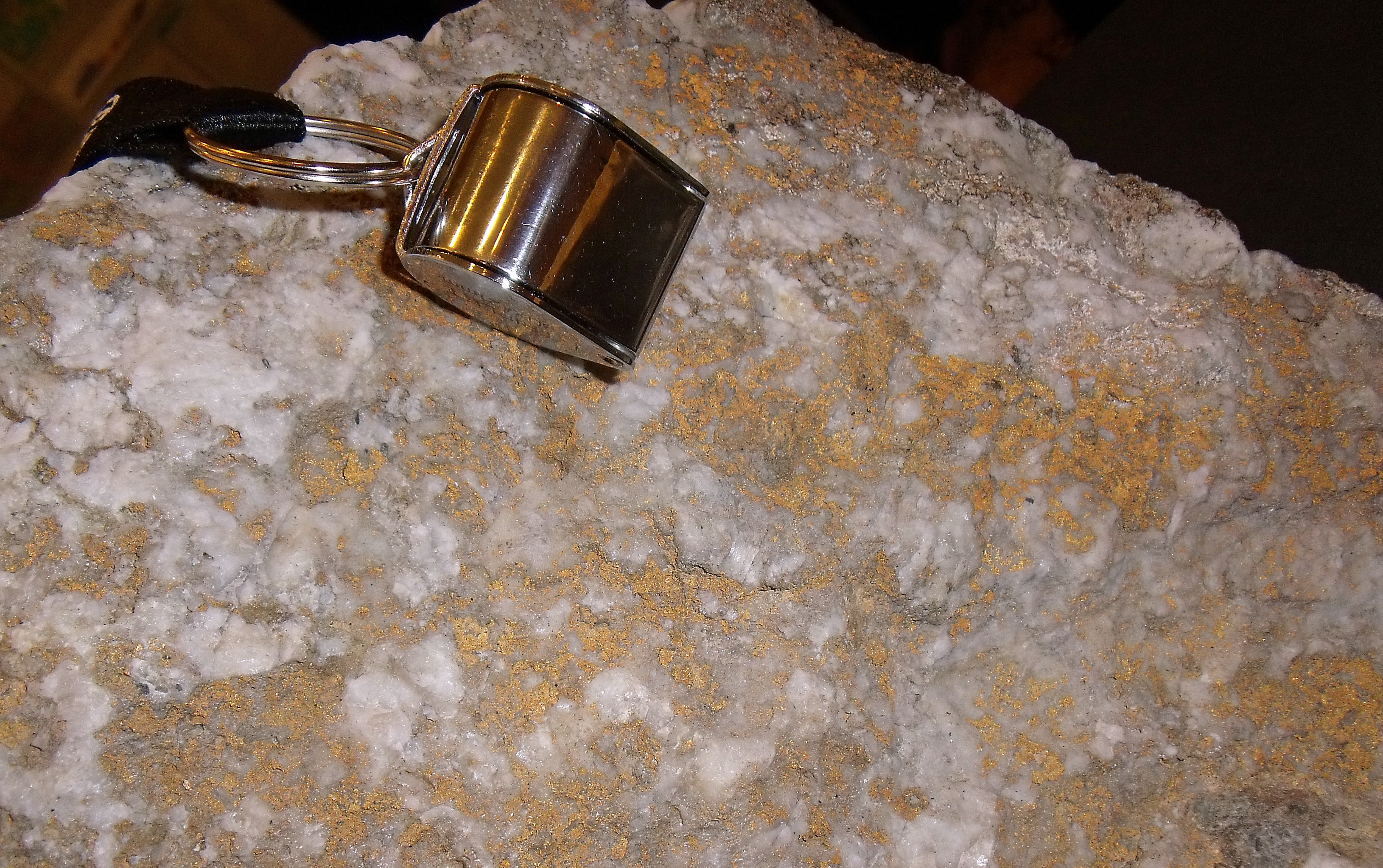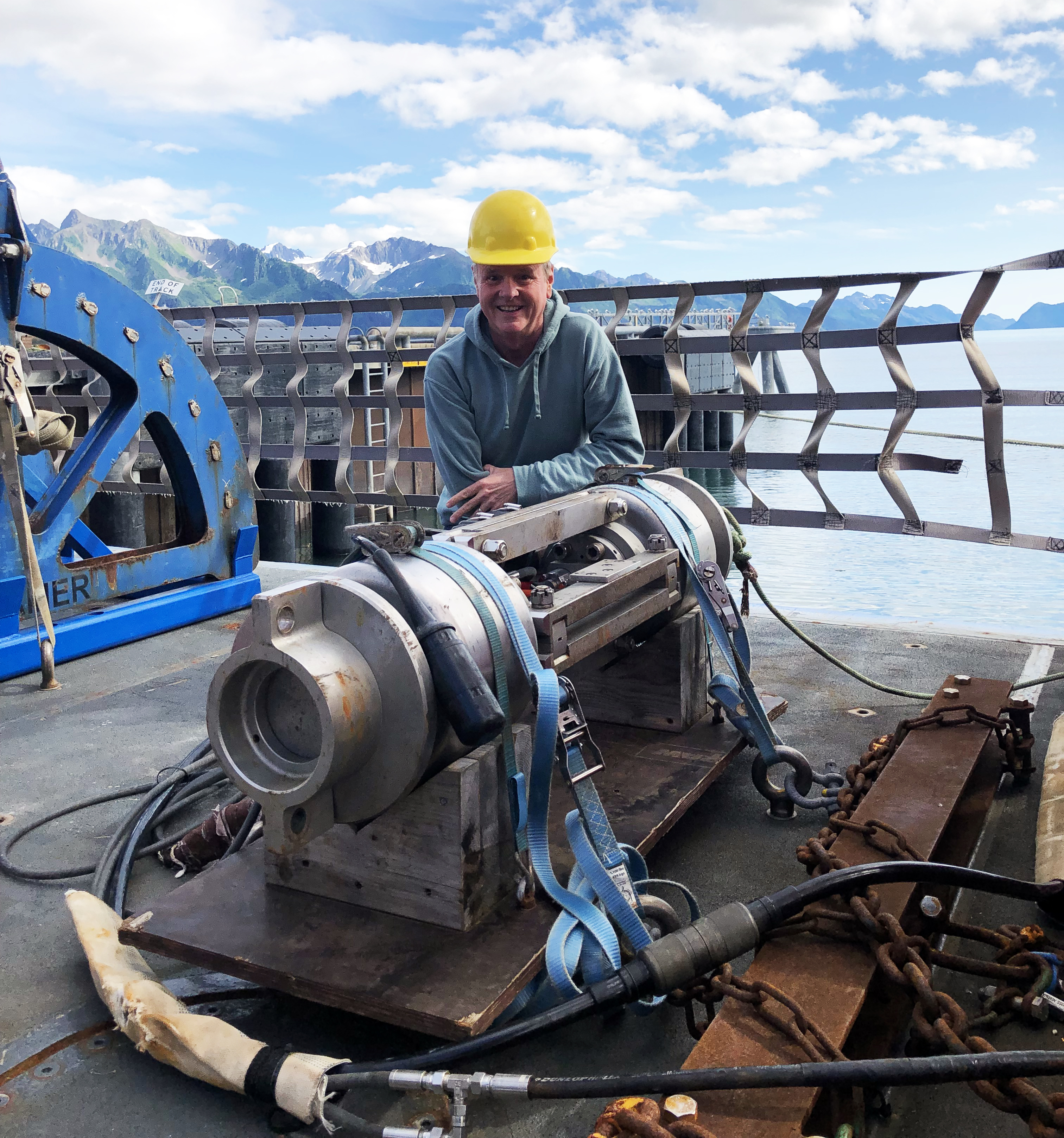|
Atomic Demolition Munition
Atomic demolition munitions (ADMs), colloquially known as nuclear land mines, are small nuclear explosive devices. ADMs were developed for both military and civilian purposes. As weapons, they were designed to be exploded in the forward battle area, in order to block or channel enemy forces. Non-militarily, they were designed for demolition, mining or earthmoving. Apart from testing, however, they have never been used for either purpose. Military uses Instead of being delivered to the target by missiles, rockets, or artillery shells, ADMs were intended to be emplaced by soldiers. Due to their relatively small size and light weight, ADMs could be emplaced by military engineers or special forces teams, then detonated on command or by timer to create massive obstructions. By destroying key terrain features or choke points such as bridges, dams, mountain passes and tunnels, ADMs could serve to create physical as well as radiological warfare, radiological obstacles to the movement of ... [...More Info...] [...Related Items...] OR: [Wikipedia] [Google] [Baidu] |
Medium Atomic Demolition Munition (internal)
Medium Atomic Demolition Munition (MADM) was a tactical nuclear weapon developed by the United States during the Cold War. It was an Atomic demolition munitions, atomic demolition munition (ADM), a combat engineering device for demolition of structures and for battlefield shaping. The device contained a W45 (nuclear warhead), W45 warhead with an estimated yield of . Each MADM weighed in its transportation container. They were deployed between 1962 and 1986. In service, the MADM was known as the M167, M172 and M175 Atomic Demolition Charges (ADCs). History The history of the MADM began in 1954 with the proposal for a light-weight multi-purpose warhead. Its predecessor, the first atomic demolition munition (ADM), was deployed in the same year. This was a low-yield weapon () used by special forces and commando teams to destroy enemy infrastructure such as bridges tunnels, and harbors, among others. The MADM warhead was designed to be economical in nuclear material, having a diamet ... [...More Info...] [...Related Items...] OR: [Wikipedia] [Google] [Baidu] |
Nuclear Explosions For The National Economy
Nuclear Explosions for the National Economy (; sometimes referred to as ''Program #7'') was a Soviet program to investigate peaceful nuclear explosions (''PNEs''). It was analogous to the United States program '' Operation Plowshare'', although the Soviet one consists of 124 tests. One of the better-known tests was '' Chagan'' of January 15, 1965. Radioactivity from the Chagan test was detected over Japan by both the U.S. and Japan in apparent violation of the 1963 Partial Test Ban Treaty (PTBT). The United States complained to the Soviets, but the matter was dropped. History In November 1949, shortly after the test of their first nuclear device on September 23, 1949, Andrey Vyshinsky, the Soviet representative to the United Nations, delivered a statement justifying their efforts to develop their own nuclear weapons capability. He said: However the USSR did not immediately follow the U.S. lead in 1958 in establishing a program. Presumably, their position in support of a compr ... [...More Info...] [...Related Items...] OR: [Wikipedia] [Google] [Baidu] |
W45 (nuclear Warhead)
The W45 was a multipurpose American nuclear warhead developed in the early 1960s, first built in 1962 and fielded in some applications until 1988. It had a diameter of , a length of and weighed . The yields of different W45 versions were 0.5, 1, 5, 8, 10, and 15 kilotons. The W45 was designed at the Livermore branch of the University of California Radiation Laboratory (UCRL), now Lawrence Livermore National Laboratory (LLNL). It was developed in part during 1958-1961. W45 used a common nuclear fission core called the Robin primary, which was used as the fission primary in the thermonuclear W38 and W47 weapons. In January 1960, the MADM version of the W45 was assigned the name W45 Mod 1. This version of the warhead was only different from the W45 Mod 0 used in Little John and Terrier in that it had no environmental sensing device, the ADM role having precluded the possibility of such a device. Instead, the warhead received a three-digit combination padlock to restrict access to ... [...More Info...] [...Related Items...] OR: [Wikipedia] [Google] [Baidu] |
W30 (nuclear Warhead)
The W30 was an American nuclear warhead used on the RIM-8 Talos surface-to-air missile and the Tactical Atomic Demolition Munition (TADM). The W30 was in diameter and long, weighing depending on the version. The Talos missile variants were produced from 1959 to 1965, and used until 1979. A total of 300 were produced as missile warheads. The W30 Mod 1, 2, and 3 for Talos all had yields of 5 (sometimes more precisely reported as 4.7) kilotons. The TADM warhead was produced from 1961 and saw service until 1966. There were two variants, the W30 Mod 4 Y1 with 0.3 kiloton yield (300 tons TNT) and the W30 Mod 4 Y2 with 0.5 kiloton (500 tons TNT) yield. 300 TADM W30s were produced, between the two versions. A yield of 19 kilotons is given in some references for an unspecified version, possibly a not-deployed high yield test only unit. The W30 is stated by nuclear researcher Chuck Hansen to have been one of two weapons using a common fission bomb core design, the Boa primary; ... [...More Info...] [...Related Items...] OR: [Wikipedia] [Google] [Baidu] |
T-4 Atomic Demolition Munition
The T4 Atomic Demolition Munition (ADM) was a nuclear weapon derived from the American W9 nuclear artillery shell. History The T4 was produced in 1957 from recycled W9 fissile components and was in service until 1963, when it was replaced with W30 Tactical Atomic Demolition Munitions and W45 Medium Atomic Demolition Munitions. The weapon weighed and could be broken down into four sections for transport by a four-man crew. Media coverage An article in the mid-1990s in '' Soldier of Fortune'' magazine by a former US Navy Underwater Demolition Team member described the T4 ADM without naming it. The description was moderately detailed, including that the T4 was assembled from separate components: *A gun barrel assembly, with the fission “bullet” and propellant and detonator A detonator is a device used to make an explosive or explosive device explode. Detonators come in a variety of types, depending on how they are initiated (chemically, mechanically, or electrica ... [...More Info...] [...Related Items...] OR: [Wikipedia] [Google] [Baidu] |
Mark 7 Nuclear Bomb
Mark 7 "Thor" (or Mk-7) was the first tactical fission bomb adopted by US armed forces. It was also the first weapon to be delivered via toss bombing with the help of the low-altitude bombing system (LABS). The weapon was tested in Operation Buster-Jangle. The Mark 7 was fitted with retractable stabilizer fins so it could be carried under fighter-bomber aircraft. The Mark 7 warhead (W7) also formed the basis of the BOAR rocket, the Mark 90 Betty nuclear depth charge, MGR-1 Honest John rocket, MGM-5 Corporal ballistic missile, and Nike Ajax surface-to-air missile. It was also supplied for delivery by Royal Air Force Canberra aircraft assigned to NATO in Germany under the command of SACEUR. This was done under the auspices of Project E, an agreement between the United States and the UK on the RAF carriage of US nuclear weapons. In UK use it was designated 1,650 lb. H.E. M.C. The Mark 7 was in service from 1952 to 1967(8) with 1,700–1,800 having been built. Design The Mark ... [...More Info...] [...Related Items...] OR: [Wikipedia] [Google] [Baidu] |
Davy Crockett (nuclear Device)
The M28 or M29 Davy Crockett Weapon System was a tactical nuclear recoilless smoothbore gun for firing the M388 nuclear projectile, armed with the W54 nuclear warhead, that was deployed by the United States during the Cold War. It was the first project assigned to the United States Army Weapon Command in Rock Island, Illinois. It remains one of the smallest nuclear weapon systems ever built, incorporating a warhead with yields of 10 to 20 tons of TNT (42 to 84 GJ). It is named after American folk hero, soldier, and congressman Davy Crockett. History By 1950, there had been rapid developments made in the use of nuclear weapons after the detonation of "Little Boy" and "Fat Man" in 1945. These developments paved the way for nuclear warheads to be created at a smaller size. Advances in nuclear weapons technology, spurred on by the first detonation of the Soviet nuclear bomb in 1949, led to great reductions in the size of nuclear weapons. By 1957, the Atomic Energy Commission ... [...More Info...] [...Related Items...] OR: [Wikipedia] [Google] [Baidu] |
Kiloton
TNT equivalent is a convention for expressing energy, typically used to describe the energy released in an explosion. A ton of TNT equivalent is a unit of energy defined by convention to be (). It is the approximate energy released in the detonation of a tonne, metric ton (1,000 kilograms) of trinitrotoluene (TNT). In other words, for each gram of TNT exploded, (or 4184 joules) of energy are released. This convention intends to compare the destructiveness of an event with that of conventional explosive materials, of which TNT is a typical example, although other conventional explosives such as dynamite contain more energy. A related concept is the physical quantity TNT-equivalent mass (or mass of TNT equivalent), expressed in the ordinary unit of mass, units of mass and its multiples: kilogram (kg), megagram (Mg) or tonne (t), etc. Kiloton and megaton The "kiloton (of TNT equivalent)" is a unit of energy equal to 4.184 Metric prefix#List of SI prefixes, terajoules (). A kil ... [...More Info...] [...Related Items...] OR: [Wikipedia] [Google] [Baidu] |
Variable Yield
Variable yield, or dial-a-yield, is an option available on most modern nuclear weapons. It allows the operator to specify a weapon's yield, or explosive power, allowing a single design to be used in different situations. For example, the Mod-10 B61 bomb had selectable explosive yields of 0.3, 5, 10 or 80 kilotons, depending on how the ground crew set a dial inside the casing when it was loaded onto an aircraft. Technology Variable yield technology has existed since at least the late 1950s. Examples of variable yield weapons include the B61 nuclear bomb family, B83, B43, W80, W85, and WE177A warheads. Most modern nuclear weapons are Teller–Ulam design type thermonuclear weapons, with a fission ''primary'' stage and a fusion ''secondary stage'' that is collapsed by the energy from the primary. These offer at least three methods to vary yield: * Varying primary yield by boosting with fusion, using small amounts of deuterium / tritium (DT) gas inside the primary fissi ... [...More Info...] [...Related Items...] OR: [Wikipedia] [Google] [Baidu] |
SADM(cropped)
SADM may refer to: * Special Atomic Demolition Munition * Morón Airport and Air Base, ICAO code: SADM {{dab ... [...More Info...] [...Related Items...] OR: [Wikipedia] [Google] [Baidu] |
Prospecting
Prospecting is the first stage of the geological analysis (followed by Mining engineering#Pre-mining, exploration) of a territory. It is the search for minerals, fossils, precious metals, or mineral specimens. It is also known as fossicking. Traditionally prospecting relied on direct observation of mineralization in rock outcrops or in sediments. Modern prospecting also includes the use of geologic, Geophysics, geophysical, and Geochemistry, geochemical tools to search for anomalies which can narrow the search area. Once an anomaly has been identified and interpreted to be a potential prospect direct observation can then be focused on this area. In some areas a prospector must also stake a claim, meaning they must erect posts with the appropriate placards on all four corners of a desired land they wish to prospect and register this claim before they may take samples. In other areas publicly held lands are open to prospecting without staking a mining claim. Historical method ... [...More Info...] [...Related Items...] OR: [Wikipedia] [Google] [Baidu] |
Vibroseis
A seismic source is a device that generates controlled seismic energy used to perform both reflection and refraction seismic surveys. A seismic source can be simple, such as dynamite, or it can use more sophisticated technology, such as a specialized air gun. Seismic sources can provide single pulses or continuous sweeps of energy, generating seismic waves, which travel through a medium such as water or layers of rocks. Some of the waves then reflect and refract and are recorded by receivers, such as geophones or hydrophones. Seismic sources may be used to investigate shallow subsoil structure, for engineering site characterization, or to study deeper structures, either in the search for petroleum and mineral deposits, or to map subsurface faults or for other scientific investigations. The returning signals from the sources are detected by seismic sensors (geophones or hydrophones) in known locations relative to the position of the source. The recorded signals are then subjecte ... [...More Info...] [...Related Items...] OR: [Wikipedia] [Google] [Baidu] |






